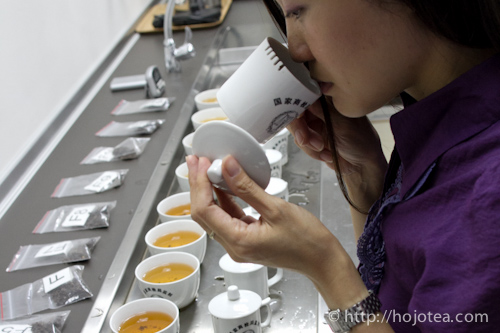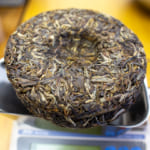- HOME >
- How to choose quality tea
Comparison is the best way to check the tea quality
- [2013.03.21] Posted By Akira Hojo
Comparison is the key to inspect the quality of tea
For tea quality aspects, it is quite difficult to put into quantitative perspective. If we could do so, our job becomes much easier, and one could find good tea regardless of one’s ability. However, this will make the tea becomes less interesting.
In some way, we will still have to do the quantitative analysis of tea’s quality in our mind. There are two aspects to look into. Firstly, the superiority of the tea material is judged based on the intensity of aftertaste. Secondly, the quality of tea processing is judged from the tea flavour profile. We must be able to determine the level of after taste and capture the flavour profile of different teas.
If you lack the experience on tasting, it is important to compare the teas’ quality by intercropping a contrast. You may need a control sample for sensory analysis. This is one of the ways that I practiced during my tea tours in China or Taiwan. We bring along the tea that we know how good it is and take it as the standard. I usually use two tea samples besides water.
- Water
- Intermediate control: Tea that I know the quality is about good.
- Superior control: Tea that I know the quality is outstandingly good.
If you pay attention to the after taste, No.1 and No.2 should be similar. Both samples give about the same level of after taste. Among the three samples, sample No.3 has relatively good after taste. In a way, you can create a standard evaluation curve in your mind. When you have more teas, it is good to choose an intermediate quality in between No.2 and No.3. Eventually, you have three guidelines to examine the intensity of after taste.
Besides, it is important to conduct the training of tasting on a daily basis. I never miss the training, unless I am sick or being away from office. Every spring, I need to purchase teas for a whole year quantity. When I am in China for purchasing tea, I cannot make an excuse saying that I do not feel well or could not smell well. As you practise tasting everyday, you will be implanted in an absolute standard curve of after taste. It is just like having an absolute pitch.
In tasting, focus on only one aspect at one time
During tea tasting, the important point is that we should not focus on too many aspects at one time. For example, we must concentrate only in the after taste when we are judging the after taste. If we like to determine the intensity of flavour, we only focus on it. It makes the quality inspection process much more systematic and simple. Conversely, if at the same time you try to inspect different aspects, you will lose direction. Here’s one of the poor example in tasting:
I give you one unfeasible example of tea tasting as follows:
- It is mellow and fruity
- It gives strong flavour, but slightly astringent
- It is bitter and smoky
From the descriptions mentioned above, you will realize that this quality inspection doesn’t make any sense. We can hardly understand either the quality or the character of each tea.
You can only look at one aspect at one time. Make sure forget about the rest of information.
In general, we analyse the following points:
- Type of flavour
- Intensity of flavour
- Smoothness (after taste)
- body
- Dryness
- Bitterness
- Colour of tea leaves
- Size of tea leaves
- Softness of tea leaves
- Other defect
Related Articles
How to get the latest update on HOJO?
1. Follow Twitter, 2. Click "Like" on Facebook, and 3. Subscribe in newsletter. You can have the latest tea news from HOJO.
 Subscribe the Newsletter to enjoy the privileges
Subscribe the Newsletter to enjoy the privileges- You may receive a free sample upon purchase, or you may have the priority to purchase special products. So please remember to subscribe our newsletter as well as the social network.
- New Arrival of Akitsu Mumyoi and Nosaka Rough Clay Teapot
- A wide selection of teaware by Watanabe Tozo, a Sado-based artist of Mumyoi-yaki, has just arrived. This time, …
- Mang Fei Ripe Pu-erh Tea 2023 – Small-Batch Production from a Renowned Region
- Mang Fei Ripe Pu-erh Tea 2023 is now available. This is one of the highest-quality ripe pu-erh teas among our …
NEW ARTICLES
 Development of Firewood Roasted Hojicha Using Naturally Grown Tea from Yunnan
Development of Firewood Roasted Hojicha Using Naturally Grown Tea from Yunnan- We are currently staying in Yunnan Province for tea production. As the season nears its end, tea trees with pa …
 Exploring the Food Culture of Yunnan: Where Minority and Sichuan Cuisines Meet
Exploring the Food Culture of Yunnan: Where Minority and Sichuan Cuisines Meet- We are currently staying long-term in Yunnan Province for spring tea production. On rainy days or when there i …
 New Arrival of Akitsu Mumyoi and Nosaka Rough Clay Teapot
New Arrival of Akitsu Mumyoi and Nosaka Rough Clay Teapot- A wide selection of teaware by Watanabe Tozo, a Sado-based artist of Mumyoi-yaki, has just arrived. This time, …
 Managing Yunnan White Tea — Insights from the Field
Managing Yunnan White Tea — Insights from the Field- Since March 25, we have been in Yunnan Province, fully engaged in the production of white tea. In this column, …
 Mang Fei Ripe Pu-erh Tea 2023 – Small-Batch Production from a Renowned Region
Mang Fei Ripe Pu-erh Tea 2023 – Small-Batch Production from a Renowned Region- Mang Fei Ripe Pu-erh Tea 2023 is now available. This is one of the highest-quality ripe pu-erh teas among our …
 Yunnan Tea Trends 2025: Insights from the Fields
Yunnan Tea Trends 2025: Insights from the Fields- Since March 25, we have been in Yunnan Province. We will stay here until May to conduct tea production, packin …
 Why Do Some Teas Taste Astringent? Exploring the Causes and Mechanisms of Astringency
Why Do Some Teas Taste Astringent? Exploring the Causes and Mechanisms of Astringency- Tea can range from having no noticeable astringency to possessing a very strong one. What causes this astringe …
 The Impact of Heat Sources on Tea Flavor
The Impact of Heat Sources on Tea Flavor- It is widely recognized that the material of a kettle plays an important role in shaping the taste of water fo …
 New Release of Tang Li Shan Ripe Pu-erh Tea 2023
New Release of Tang Li Shan Ripe Pu-erh Tea 2023- We have released the 2023 edition of Tang Li Shan Ripe Pu-erh Tea. Tang Li Shan refers to a mountain located o …
 The New Release of Dong Shan Raw Pu-erh Tea 2023 and Jasmine Silver Needle
The New Release of Dong Shan Raw Pu-erh Tea 2023 and Jasmine Silver Needle- We have released Dong Shan Raw Pu-erh Tea 2023 and Jasmine Silver Needle. Dong Shan Raw Pu-erh Tea 2023 We hav …
Category
- New Arrival at HOJO Online Shop
- Featured Articles
- Newsletter
- Types of Tea
- Origin of Tea
- Teapot and Tea Equipment
- Tea Column
- How to enjoy tea
- Tea Processing
- How to choose quality tea
- Tea constituents and functional effect
- Safety of Tea
- Foods
- Tea Business Operation
- Hobby and Outdoor Activity
- Ranking of Tea
- Video
- FAQ
- Media Release
Profile

- AKIRA HOJO
- I invite you to experience my tea selections.I was born in Nagano, Japan. In university, I studied agricultural chemistry, and I have the master degree in food science. I worked in Japanese food industry for 10 years. I involved in R&D, QC and QA. As a factory manager, I implemented ISO9000 series and managed the factory.
- The Art of Tea Magazine
- We posted the article on “The Art of Tea Magazine No.9, the magazine is published in Taiwan. We featured …
- New Straits Times
- The Malaysian National Newspaper, New Straits Times featured HOJO Tea on 17-Oct-2007.
Shop Info

Address:Lot No. T-215, 3rd Floor, The Gardens Mall, Mid Valley City, Lingkaran Syed Putra, 59200 Kuala Lumpur
Tel: +603-2287-4537
Business Hour: 10am to 10pm















